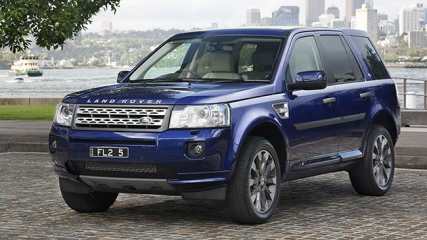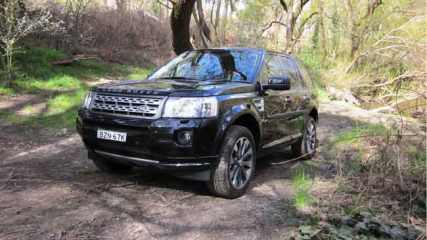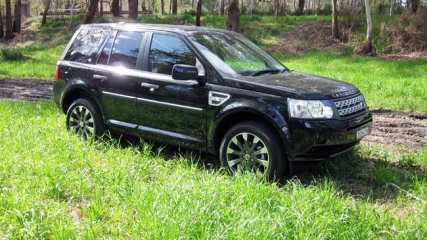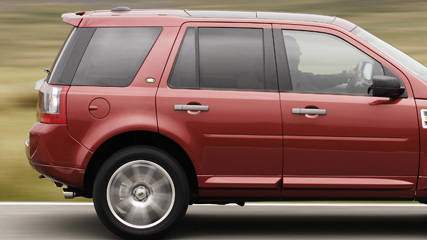Land Rover Freelander 2007 review
By Stuart Martin · 12 Oct 2011
If a car brand completely resists trends and change, there's every chance it won't live to regret the decision. Land Rover - like Jeep in many ways - resisted the soft-roader trend, preferring to keep things like dual range, ground clearance and off-road ability before indulging in metrosexual tendencies.Both hard-core 4WD brands succumbed and Land Rover's result was the Freelander, which is without a transfer case and sits lower than the rest of the Land Rover range - but don't mistake it for an overgrown shopping trolley built for the school run and nothing else.We're in the range-topping SD4 HSE - which has a lofty $65,854 asking price before any stickers are added or taxes paid. That's not cheap'n'cheerful, but patience - the contents list includes satellite navigation, steering wheel controls for audio, cruise and phone, dual zone climate control, manual reach and rake steering adjustment, power-adjustable front seats with armrests, automatic xenon headlights, parking sensors front and rear (but no rear camera), Bluetooth phone link, leather trim for the seats, steering wheel, gearshifter and console, trip computer, dual-zone climate control, automatic headlights and windscreen wipers.The test car was also packing gear from the HSE Premium Luxury package, which adds $6890 to the bottom line and among its inclusions are adaptive function for the headlights, 19in 10-spoke diamond cut alloy wheels (including a full-size spare), an auto-dimming rearvision mirror, heating for the front seats, a heated front windscreen (for the snow bunnies), upgraded leather trim and the Alpine 13-speaker surround sound system. The option box for the double sunroof (for $3300) and black metallic paint (a $1700 hit) were also ticked, taking the as-tested priced to a grand total of $78,144.The little Landie packs plenty of good stuff, although this particular engine misses out on the start-stop fuel saving system found elsewhere in the range, there's brake energy recovery to keep the battery charged up.The 2.2-litre turbodiesel is a common-rail unit that employs balance shafts to keep it smooth - Land Rover's own figures suggest it is one decibel quieter than the in-line six-cylinder petrol. The powerplant produces 140kW at 3500rpm, which is not too far short of the petrol engine's 171kW effort. The diesel has a peak torque figure of 420Nm and a combined fuel consumption claim of 7 litres per 100km, 103Nm more than the petrol engine and using 3.7 fewer litres per 100km. The Freelander sips from a 68-litre tank, suggesting an open-road touring range of 1000km would be possible.Where the Freelander has an advantage over much of its compact SUV competition is the Terrain Response drivetrain system that tailors the car's electronic systems to the impending terrain.Although not as advanced as the Terrain Response in its larger brethren - in the case of the Range Rover Sport now has a dynamic driving mode for the active suspension - the Freelander has four modes - general driving, grass/gravel/snow, mud/ruts and sand - for getting it a little bit dirty.The stability and traction control systems, as well as the Haldex four-wheel drive system, work together to endow the Freelander with a level of offroad ability well beyond the segment average. The drivetrain uses an electronically-controlled rear diff to put drive to the rear wheels as required, via a six-speed automatic transmission, as well as a hill-start and downhill assistance systems.It's not quite a mini Disco or Defender, nor is it a pint-sized Rangie (they've done that now anyway) but the Freelander has aspects of all three - the front grille in particular - within its fairly conventional exterior package. That's far from a bad thing as the Land Rover breed has always produced handsome machinery, from the rugged utilitarian 110 and Defender models through the to the regal and arrogant supremacy exuded by the Range Rover.The cabin follows suit, adopting (as you'd expect) switchgear and dash layouts from the rest of the family. The test car's burnt orange interior might not be the first choice in trim colour but the ergonomics of the interior are much-improved over earlier Land Rover product - the only way in many cases was up.Aside from the inherent active safety of all-wheel drive, the Freelander employs anti-lock brakes with emergency braking assistance (which the company says can reduce stopping distances by up to 15 per cent) and brakeforce distribution systems. Some of the same hardware also deploys in the form of traction and stability control, as well as cornering braking and anti-rollover control systems. The passive safety features list includes dual front, front-side airbags and full-length side-curtain airbags, as well as a driver's knee airbag.This segment is awash with vehicles that have no chance of overcoming a wet grassy slope at a country footy game - the Freelander is not one of those soft-roader wanna-bes. The green oval badge would (I hope) fall off in disgust if it weren't capable of getting its Continental rubber grotty and ploughing on unfazed. Granted, it's never going to clamber over the terrain its brethren can, but it will certainly complete more arduous tasks than the bulk of its competitive set.Terrain Response is off-roading for dunces and - provided you have faith in the under-body protection - it can be bumped and thumped over some more challenging terrain. Tracks violated by big ruts left by large off-roaders will offer the Freelander a challenge only through lack of clearance, which is decent for the segment at 210mm, not from a lack of tractive performance from the drivetrain. On the bitumen, the Freelander is a very comfortable conveyance - the top-spec leather seats are well-cushioned (if not heavily endowed with lateral support).Ride comfort is more supple than the German prestige competitors and while body roll is a little more prevalent, it's not a roly-poly mess like the original Range Rovers - it progresses with purpose once settled into a bend.The driver has enough adjustment to get a good position behind the wheel and rear seat head and leg space is still reasonable with taller occupants in the front.The diesel is reasonably quiet and offers a solid shove in the back from low in the rev range, without having to resort to full throttle - punch it hard and Land Rover says it will hit 190km/h and only takes 9.5 seconds to hit 100km/h, which is not far off the petrol six-cylinder model's claim.In cabin storage is reasonably good but the level of connectivity isn't up to par - no USB socket or Bluetooth link for the music, just a 3.5mm jack.There are cheaper prestige alternatives in this segment - as well as a well-mannered local - but what price to pay for the compact SUV with badge cred? It is probably top of the pops in off-road terms and pretty good on the bitumen too, but the high asking price takes the shine from the Freelander.








